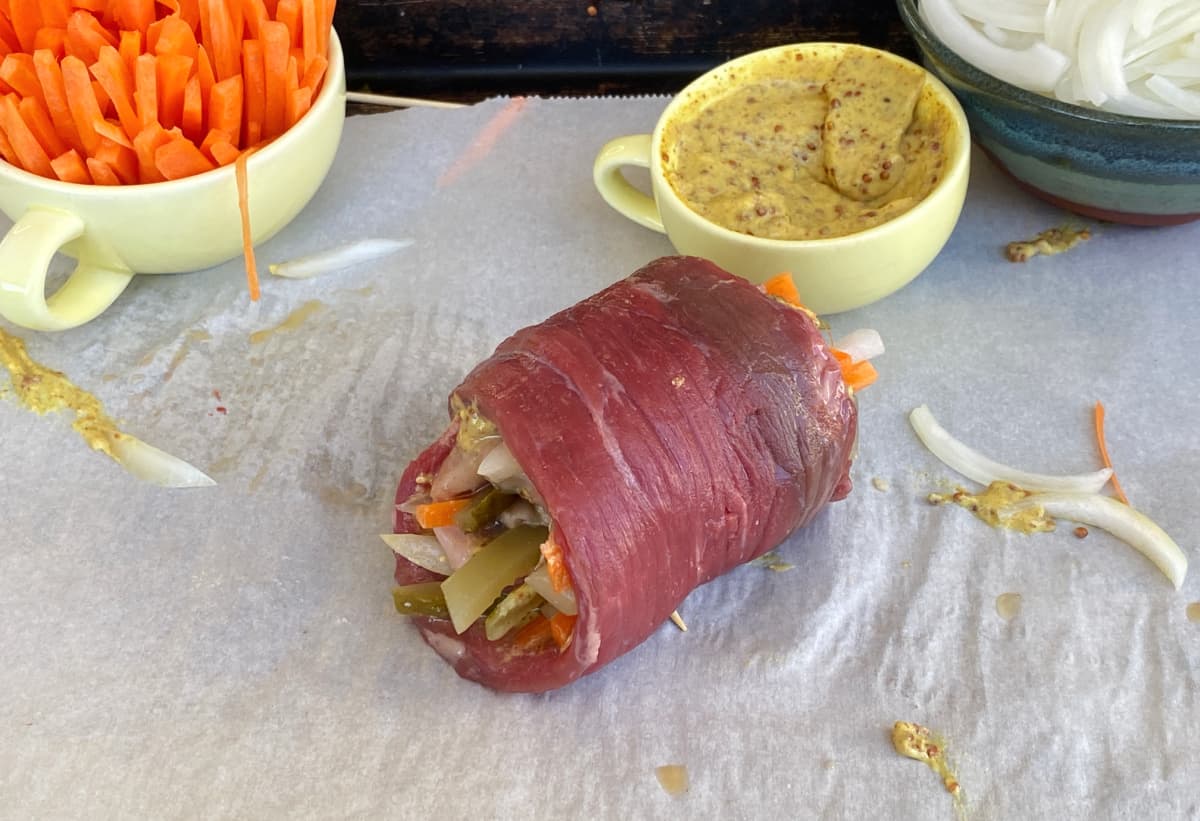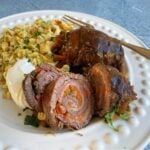Beef Rouladen is a classic, hearty German comfort dish made with thinly sliced beef rolled with savory mixture of bacon, onions, mustard, and pickles, then browned and slow-braised to perfection in an umami-rich gravy.

Jump to:
Why You Will Love this Recipe
Beef rouladen is one of our all-time favorite German recipes! Mouthwateringly delicious and dressed to impress, beef rouladen (Rinderrouladen) is classic German comfort food that's perfect for Sunday dinners or holiday celebrations. Slow-braising results in beef rolls that are rich, satisfying, and impossibly tender. And that gravy? Absolutely heavenly, with savory umami levels that are off the charts!
But what makes this flavor combo so unique?
If you've had beef rouladen in the past and wondered what makes it so crazy rich and savory, you might be in for a surprise! The secret ingredient in this classic German dish is pickle juice! Yes, that tangy, briny liquid that typically gets poured down the drain is a game-changer in beef rouladen. When incorporated into the braising liquid, pickle juice infuses the meat with a unique depth of flavor. The acidity of the pickle juice helps to tenderize the beef, while its tanginess enhances the savory components of the dish.
Plan on adding this recipe to your weekend dinner rotation! Surprisingly simple to prepare, beef rouladen can be made well in advance, making them both convenient and impressive.
Beef Rouladen Ingredients
Like the preparation itself, the ingredients for beef rouladen are simple and easy to gather.
- Thinly sliced beef: I usually use round steak, but other similar cuts of beef will work work just as well (e.g., bottom round, sirloin, ribeye, flank, etc.) cut ⅛ to ¼ inch thick.
- Our local grocery store sells thinly sliced round steak labeled "for carne asada," which works perfectly for this rouladen recipe.
- Ask your butcher to cut thin beef strips for you. They will even pound it thinner for you if you prefer.
- Bacon: Look for bacon with a medium thickness - not too thick, not too thin.

You will also need:

- Mustard: I like to use a 50/50 mixture of German yellow mustard and Maille Whole Grain Mustard. You can use any mustard you like, although I personally avoid Dijon when making this recipe.
- Dill pickles: Julienne the pickles into matchstick-size pieces. We always use our homemade spice dill pickles. You'll need some of the pickle juice, too.
- Onion: I prefer to use a sweet onion. Slice the onions thinly from root to blossom end.
- Carrots: Cut the carrots into matchsticks.
- Leeks: Clean the leeks well, and cut into ½-inch pieces.
- Beef broth: Use a low-salt beef broth for more control over the seasonings.
- Red wine: Use a robust red (e.g., merlot, malbec, cab, etc.)
- If you avoid alcohol, you can use grape juice instead.
- Tomato paste: You can substitute ketchup if necessary.
- Salt and pepper
- Vegetable oil
- Butter
- Flour (Wondra) or corn starch for thickening
- Fresh parsley (for garnish)
- Sour cream (optional, for gravy & garnish)
See recipe card for quantities.
How to Make this Recipe
Rouladen aren't difficult to make, but they do take a little time to assemble. The good news is, you can make them up to a day in advance, and chill them in the fridge until you're ready to cook them.
Preheat oven to 325℉ (165℃).
- A. Lay the beef steaks out on a sheet of clean parchment paper.
- B. Spread each one with a thin layer of mustard.
- C. Lay a slice of bacon on top.
- D. Top with julienned pickles, carrots, and sweet onion, leaving 2-3-inches at one end.

Roll tightly, going from the pickles-n-carrots end toward the empty end, tucking in any loose pieces.

When completely rolled, use a toothpick or tie with kitchen twine to secure the end. Do not roll too tight.

Repeat with remaining beef steaks. Set aside any unused cut vegetables.
Heat the butter and vegetable oil in a deep, heavy skillet over medium-high heat. (Using half oil and half butter allows the meat to brown well without burning the milk solids in the butter.)

Use tongs to place the prepared beef rolls into the hot oil, turning as needed to brown them well on all sides.

Remove rouladen from skillet and set aside on a plate.
- E. Add the chopped leeks to the skillet, and cook for about 3 minutes, stirring often.
- F. Add any unused julienned vegetables and stir.
- G. Pour in the red wine all at once. Bring to a boil, and use a wooden spoon to loosen any bits from the bottom of the pan. Reduce heat to medium and simmer for 2-3 minutes.
- H. Add the beef stock, pickle juice, tomato paste, and brown sugar. Stir to combine.

Settle the browned rouladen into the leek and celery mixture.

Cover with lid or heavy aluminum foil and place in preheated oven. Bake for 1¼ - 2 hours, until beef is fork tender and the center of the rouladen registers 190-200℉ (~90℃).
Remove rouladen from Dutch oven and transfer to a serving dish. Strain remaining liquid and vegetables, reserving the liquid. The vegetables can be pureed to return to the gravy, or composted.
Return the reserved liquid to the skillet and bring to a simmer over low heat.

To make gravy with flour or Wondra, simply whisk it into the simmering liquid. Keep whisking until the gravy thickens.
To make gravy with cornstarch, first make a slurry with ¼ cup of cold water or beef broth, and then whisk the slurry into the hot liquid. (Gluten-free option)
Optionally, you can add a dollop of sour cream or a pour of heavy cream for a thicker, richer gravy.

Gently remove the toothpicks or cooking twine. Return the rouladen to the gravy to rewarm before serving.
Storage
To store rouladen, keep in sauce and cover with an airtight lid or use a vacuum sealer to seal it. Refrigerate cooked rouladen for up to 3 days, or freeze for up to 3 months. Thaw in the refrigerator before reheating.

If you enjoy this easy Beef Rouladen recipe, here are a few more tasty traditional German recipes you might like:
- Bavarian-style German Lentil Soup (Linsensuppe)
- Traditional German Sauerbraten
- Easy Apple Strudel (Apfelstrudel)
- German Dark Rye Bread
- Crispy Sauerkraut Fritters
What to Serve with Rouladen
Beef Rouladen is best served with simple, common side dishes; our favorite pairing being homemade spätzle. It's also delicious with mashed potatoes and roasted vegetables, as well as traditional German sides like Rotkohl (braised red cabbage), Kartoffelsalat (hot German potato salad), Speckbohnen (green beans with bacon), Sauerkraut, Kartoffelklöße (potato dumplings), and Gurkensalat (cucumber salad).

German Beef Rouladen
Equipment
- 1 Enameled Cast Iron Skillet or large oven-proof skillet
- 1 Tongs
- 1 Wooden Spoon
- 1 Colander or wire sieve
Ingredients
- 8 sliced beef top round sliced ⅜-¼ inch thick
- ¼ cup spicy brown mustard or German mustard
- 8 slices bacon thin or medium cut; not too thick
- 2 medium dill pickles julienned
- 1 medium carrot julienned
- ½ medium sweet onion thinly sliced lengthwise; root to blossom
- 1 tablespoon butter
- 1 tablespoon vegetable oil
- 1 cup red wine
- 2 medium leeks chopped
- 2 cups low sodium beef broth
- ¼ cup dill pickle juice
- 1 tablespoon brown sugar
- 1 tablespoon tomato paste or ketchup
- 2 tablespoons flour (recommended: Wondra) or cornstarch
- 1 dash kosher salt to taste
- 1 teaspoon Freshly ground pepper to taste
Instructions
- Preheat oven to 325℉ (165℃)
- Lay the beef steaks out on a sheet of clean parchment paper. Spread each one with a thin layer of mustard and lay a slice of bacon on top. Top with julienned pickles, carrots, and sweet onion, leaving 2-3-inches at one end.
- Roll tightly, going from the pickles-n-carrots end toward the empty end, tucking in any loose pieces. When completely rolled, use a toothpick to secure the end. Repeat with remaining beef steaks. Set aside any unused cut vegetables.
- Heat the butter and vegetable oil in a deep, heavy skillet over medium-high heat.Use tongs to place the prepared beef rolls into the hot oil, turning as needed to brown them well on all sides. Remove rouladen from skillet and set aside on a plate.
- Add the chopped leeks to the skillet, and cook for about 3 minutes, stirring often. Add unused julienned vegetables and stir. Pour in the red wine all at once. Bring to a boil, and use a wooden spoon to loosen any bits from the bottom of the pan. Reduce heat to medium and simmer for 2-3 minutes.Add the beef stock, pickle juice, tomato paste, and brown sugar. Stir to combine.
- Settle the browned rouladen into the leek and celery mixture. Cover with lid or heavy aluminum foil and place in preheated oven. Bake for 1¼ - 2 hours, until beef is fork tender and the center of the rouladen registers 190-200℉ (~90℃).
- Remove rouladen from Dutch oven and transfer to a serving dish.
- Strain remaining liquid and vegetables, reserving the liquid. The vegetables can be pureed to return to the gravy, or composted. Return the reserved liquid to the skillet and bring to a simmer over low heat.
- To make gravy with flour or Wondra, simply whisk it into the simmering liquid. Keep whisking until the gravy thickens. To make gravy with cornstarch, first make a slurry with ¼ cup of cold water or beef broth, and then whisk the slurry into the hot liquid. Optionally, you can add a dollop of sour cream or a pour of heavy cream for a thicker, richer gravy.
- Gently remove the toothpicks or cooking twine. Return the rouladen to the gravy to rewarm before serving.
Notes
Nutrition
This website provides approximate nutrition information for convenience and as a courtesy only. You are solely responsible for ensuring that any nutritional information provided is accurate, complete, and useful.
Love it? Pin it! If you love this classic German rouladen recipe, be sure to save it! Pin it to your favorite Pinterest recipe board before you go!

Thank you for visiting the Good Hearted Woman. Remember to bookmark this site, and come back soon!








Leave a Reply